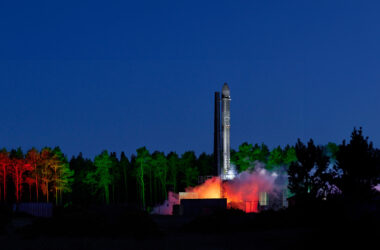UK aerospace giant Rolls-Royce recently unveiled a prototype modular nuclear fission reactor designed to provide sustainable power for establishing a continuous human presence on the Moon.
The 1-meter-wide by 3-meter extended reactor model was presented at the UK Space Conference in Belfast as part of an ongoing UK Space Agency research initiative into nuclear-enabled space exploration.

The reactor concept model ( though incapable of producing electricity ) demonstrates the potential for small, portable nuclear power systems to support lunar habitats, vehicles, and spacecraft. By the early 2030s, Rolls-Royce aims to have an operational microreactor ready for lunar surface missions that can provide energy regardless of sunlight availability.
The technology could also find applications in low Earth orbit. The Micro Reactor Concept relies on nuclear fission processes similar to those used in conventional Earth-based atomic power plants. The fission of an element like uranium produces heat that can be captured to generate electrical energy through steam or other means. This provides consistent energy output regardless of external conditions, an advantage over solar power solutions. The system’s small size and modular setup will allow it to be customised for each deployment.
Rolls-Royce is developing the reactor initiative through a £2.9 million grant from the UK Space Agency awarded earlier this year. The funding supports research into the reactor’s essential systems – its fissionable nuclear fuel materials, thermal energy transfer mechanisms, and energy conversion technologies for transforming heat into usable electricity.
The company works with various universities and industry partners, including the Nuclear Advanced Manufacturing Research Centre, to investigate and mature the system. Rolls-Royce aims to produce a resilient lunar power solution based on proven terrestrial nuclear and spacecraft technologies by bringing together expertise from the space, energy, and defence sectors.
A micro nuclear fission system’s ability to provide continuous, abundant energy anywhere could enable sustained lunar surface operations critical to scientific discovery, mining, manufacturing, and exploration across the shadowed polar craters and sunlit terrain.
The technology also promises more nimble low Earth orbit missions such as satellite manoeuvring, debris removal, and national security operations by alleviating energy limitations facing current electronic propulsion systems. These portable microreactors show commercial promise as clean energy systems for remote regions and rapid deployment of emergency power needs on Earth.
The modular reactor prototype unveiled in Belfast is the first step toward full-scale Moon microreactor demos within the decade. By mastering nuclear fission’s potential beyond Earth, we hope the UK strengthens indigenous space capabilities and stands poised to shape sustainable human expansion into the cosmos.
TLDR:
- Rolls-Royce unveils 1×3 meter modular nuclear reactor prototype for lunar missions
- Uses nuclear fission for continuous power regardless of sunlight
- Aims for flight-ready system by early 2030s to support moon base, rovers
- Part of UK Space Agency program to develop nuclear power in space
- It could also boost satellites, enable challenging spacecraft manoeuvres
- Terrestrial applications as transportable clean energy systems







